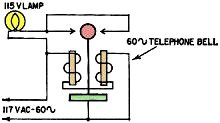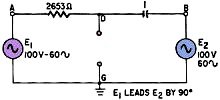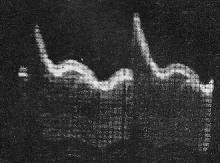|
February 1962 Radio-Electronics
 [Table of Contents] [Table of Contents]
Wax nostalgic about and learn from the history of early electronics.
See articles from Radio-Electronics,
published 1930-1988. All copyrights hereby acknowledged.
|
Here we are with
another set of three "What's Your EQ?" circuit challenges, these from the
February 1962 issue of Radio-Electronics magazine. As usual, those
challenges provided by Jack Darr are the purview of television servicemen of the
era. The photo shown of the problematic CRT display looks like a chest x-ray or
maybe hieroglyphics in the dark corner of a cave, but evidently the artifacts
are readily identifiable to an initiated few. The Forbidden Current Path circuit
answer is not what I thought it would be. I maintain that whether my answer or
the designer's answer is correct depends on the physical configuration of the
solenoids, clapper, and contacts, as well as the material type used in the
clapper arm (see my guess below). "Simple (?) AC Problem" shouldn't provide too
much effort, especially for the Point A - Point B part (hint: add or subtract in
terms of complex voltages, i.e, Real ± j Imaginary).
What's Your EQ?
 It's stumper time again. Here are three little beauties that will give you a
run for the money. They may look simple. but double-check your answers before you
say you've solved them. For those that get stuck, or think that it just can't be
done, see the answers next month. If you've got an interesting or unusual answer
send it to us. We are getting so many letters we can't answer individual ones, but
we'll print the more interesting solutions (the ones the original authors never
thought of). Also, we're in the market for puzzlers and will pay $10 and up for
each one accepted. Write to EQ Editor, Radio-Electronics, 154 West 14th St .• New
York, N. Y. It's stumper time again. Here are three little beauties that will give you a
run for the money. They may look simple. but double-check your answers before you
say you've solved them. For those that get stuck, or think that it just can't be
done, see the answers next month. If you've got an interesting or unusual answer
send it to us. We are getting so many letters we can't answer individual ones, but
we'll print the more interesting solutions (the ones the original authors never
thought of). Also, we're in the market for puzzlers and will pay $10 and up for
each one accepted. Write to EQ Editor, Radio-Electronics, 154 West 14th St .• New
York, N. Y.
For answers to last month's puzzle see page 58.
 Forbidden Current Path Forbidden Current Path
In this hookup, a standard ac ringer is so hooked up that the clapper makes a
good contact with a pair of contacts at each end of its swing, putting the lamp
across the line. Why doesn't the lamp light when the bell is ringing and the clapper
is making contact?
- I. S. Kerstetter
 Simple (?) AC Problem Simple (?) AC Problem
In the circuit shown two ac generators furnish the two voltages E1
and E2. E1 and E2 are both 100 volts (rms)
60 cycles, but E1 leads E2 by 90°. (In other words, the
potential of point A with respect to ground G reaches its maximum or peak value
one quarter-cycle earlier than the potential of point B with respect to G does.)
a. What will be the voltage between points A and B, and what will be the voltage
between points D and G?
b. Will it make any difference, as far as these two voltages are concerned, if
the resistor and capacitor are interchanged (that is, the capacitor is placed between
points A and D, and the resistor between points D and B)?
(To save calculation, the capacitive reactance of a 1-μf capacitor at 60 cycles
is 2653 ohms.)
- Walther Richier
 Service Stinker No.3 Service Stinker No.3
Look at the picture. What is the trouble? Horizontal phase diode out? Bad horizontal
oscillator?
- Jack Darr
Quizzes from vintage electronics magazines such as Popular
Electronics, Electronics-World, QST,
Radio-Electronics, and Radio News
were published over the years - some really simple and others not so simple. Robert P. Balin
created most of the quizzes for Popular Electronics. This is a listing
of all I have posted thus far.
- RF Cafe Quiz #71:
Tech Headlines for Week of 3/13/2023
- RF Cafe Quiz #70:
Analog &
RF Filter Basics
- RF Cafe Quiz #69:
RF
Electronics Basics
- RF Cafe Quiz #68:
RF & Analog Company Mergers & Acquisitions in 2017
- RF Cafe Quiz #67:
RF & Microwave Company Name Change History
- RF Cafe Quiz #66:
Spectrum and Network Measurements
- RF Cafe Quiz #65:
Troubleshooting & Repairing Commercial Electrical Equipment
- RF Cafe Quiz #64:
Space-Time Adaptive Processing for Radar
- RF Cafe Quiz #63:
Envelope Tracking Power Amplifiers
- RF Cafe Quiz #62:
Stimson's Introduction to Airborne Radar
- RF Cafe Quiz #61:
Practical Microwave Circuits
- RF Cafe Quiz #60:
Ten Essential Skills for Electrical Engineers
- RF Cafe Quiz #59:
Microwave Circulator Design
- RF Cafe Quiz #58:
Microwave and Millimeter-Wave Electronic Packaging
- RF Cafe Quiz #57:
Frequency-Agile Antennas for Wireless Communications
- RF Cafe Quiz #56:
Tube Testers
and Electron Tube Equipment
- RF Cafe Quiz #55:
Conquer
Radio Frequency
- RF Cafe Quiz #54:
Microwave Mixer Technology and Applications
- RF Cafe Quiz #53:
Chipless RFID Reader Architecture
- RF Cafe Quiz #52:
RF and Microwave Power Amplifiers
- RF Cafe Quiz #51:
Antennas and Site Engineering for Mobile Radio Networks
- RF Cafe Quiz #50:
Microstrip Lines and Slotlines
- RF Cafe Quiz #49:
High-Frequency Integrated Circuits
- RF Cafe Quiz #48:
Introduction to Infrared and Electro-Optical Systems
- RF Cafe Quiz #47:
LCP for Microwave Packages and Modules
- RF Cafe Quiz #46:
RF, Microwave, and Millimeter-Wave Components
- RF Cafe Quiz #45:
Dielectric and Thermal Properties of Materials at Microwave Frequencies
- RF Cafe Quiz #44:
Monopulse Principles and Techniques
- RF Cafe Quiz #43:
Plasma Antennas
- RF Cafe Quiz #42: The Micro-Doppler
Effect in Radar
- RF Cafe Quiz #41: Introduction
to RF Design Using EM Simulators
- RF Cafe Quiz #40: Introduction
to Antenna Analysis Using EM Simulation
- RF Cafe Quiz #39: Emerging
Wireless Technologies and the Future Mobile Internet
- RF Cafe Quiz #38: Klystrons,
Traveling Wave Tubes, Magnetrons, Crossed-Field Amplifiers, and Gyrotrons
- RF Cafe Quiz #37: Component
Reliability for Electronic Systems
- RF Cafe Quiz #36: Advanced
RF MEMS
- RF Cafe Quiz #35: Frequency
Synthesizers: Concept to Product
- RF Cafe Quiz #34: Multi-Gigabit
Microwave and Millimeter-Wave Wireless Communications
- RF Cafe Quiz #33: Battlespace
Technologies: Network-Enabled Information Dominance
- RF Cafe Quiz #32: Modern Communications
Receiver Design and Technology
- RF Cafe Quiz #31: Quantum
Mechanics of Nanostructures
- RF Cafe Quiz #30: OFDMA System
Analysis and Design
- RF Cafe Quiz #29: Cognitive
Radar
- RF Cafe Quiz #28: Human-Centered
Information Fusion
- RF Cafe Quiz #27: Remarkable
Engineers
- RF Cafe Quiz #26: Substrate
Noise Coupling in Analog/RF Circuits
- RF Cafe Quiz #25: Component
Reliability for Electronic Systems
- RF Cafe Quiz #24: Ultra Low
Power Bioelectronics
- RF Cafe Quiz #23: Digital
Communications Basics
- RF Cafe Quiz #22: Remember
the Basics?
- RF Cafe Quiz #21: Wireless
Standards Knowledge
- RF Cafe Quiz #20: Famous First
Names
- RF Cafe Quiz #19: Basic Circuit
Theory
- RF Cafe Quiz #18: Archaic
Scientific Words & Definitions
- RF Cafe Quiz #17: Inventors &
Their Inventions
- RF Cafe Quiz #16: Antennas
- RF Cafe Quiz #15: Numerical
Constants
- RF Cafe Quiz #14: Oscillators
- RF Cafe Quiz #13: General
Knowledge
- RF Cafe Quiz #12: Electronics
Corporations Headquarters
- RF Cafe Quiz #11: Famous Inventors &
Scientists
- RF Cafe Quiz #10: A Sampling
of RF & Wireless Topics
- RF Cafe Quiz #9: A Smorgasbord
of RF Topics
- RF Cafe Quiz #8: Hallmark Decades
in Electronics
- RF Cafe Quiz #7: Radar Fundamentals
- RF Cafe Quiz #6: Wireless Communications
Fundamentals
- RF Cafe Quiz #5: Company Logo
Recognition
- RF Cafe Quiz #4: General RF
Topics
- RF Cafe Quiz #3: General RF/Microwave
Topics
- RF Cafe Quiz #2: General RF
Topics
- RF Cafe Quiz #1: General RF
Knowledge
- Vacuum Tube Quiz,
February 1961 Popular Electronics
- Kool-Keeping Kwiz, June
1970 Popular Electronics
- Find the Brightest
Bulb Quiz, April 1960 Popular Electronics
-
Where Do the Scientists Belong? - Feb 19, 1949 Saturday Evening Post
|
-
What's
Your EQ? - July 1962 Radio-Electronics
-
What's
Your EQ? - January 1962 Radio-Electronics
-
What's
Your EQ? - February 1962 Radio-Electronics
-
What's
Your EQ? - March 1962 Radio-Electronics
-
What's
Your EQ? - July 1961 Radio-Electronics
-
What's
Your EQ? - August 1961 Radio-Electronics
-
Can You
Name These Strange Electronic Effects? - August 1962 Radio-Electronics
-
What's
Your EQ? - September 1961 Radio-Electronics
-
What's
Your EQ? - September 1962 Radio-Electronics
-
What's Your EQ? - October 1961 Radio-Electronics
-
What's Your EQ? - November 1961 Radio-Electronics
-
What's Your EQ? - March 1964 Radio-Electronics
-
What's Your EQ? - April 1962 Radio-Electronics
-
What's Your EQ? - May 1962 Radio-Electronics
-
What's Your EQ? - June 1962 Radio-Electronics
-
What's Your EQ? - April 1967 Radio-Electronics
-
What's Your EQ? - March 1967 Radio-Electronics
-
What's Your EQ? - December 1964 Radio-Electronics
-
What's Your EQ? - January 1967 Radio-Electronics
-
Wanted: 50,000 Engineers - January 1953 Popular Mechanics
-
What's Your EQ? - August 1964 Radio-Electronics
- Voltage Quiz
- December 1961 Popular Electronics
-
What is It? - June 1941 Popular Science
- What Do You Know
About Resistors? - April 1974 Popular Electronics
-
What's Your EQ? - September 1963 Radio-Electronics
- Potentiometer Quiz - September
1962 Popular Electronics
-
Mathematical Bafflers - March 1965 Mechanix Illustrated
- Op Amp Quiz -
October 1968 Popular Electronics
- Electronic "A"
Quiz - April 1968 Popular Electronics
-
What's Your EQ? - May 1961 Radio-Electronics
-
Popular Science Question Bee - February 1939 Popular Science
-
What is It? - A Question Bee in Photographs - June 1941 Popular Science
-
What's Your EQ? - June 1961 Radio-Electronics
-
What's Your EQ? - June 1964 Radio-Electronics
-
What's Your EQ? - May 1964 Radio-Electronics
-
What's Your EQ? - August 1963 Radio-Electronics
-
What's Your EQ? - May 1963 Radio-Electronics
- Bridge
Function Quiz - September 1969 Radio-Electronics
-
What's Your EQ? - March 1963 Radio-Electronics
-
What's Your EQ? - February 1967 Radio-Electronics
-
Circuit Quiz - June 1966 Radio-Electronics
-
What's Your EQ? - June 1966 Radio-Electronics
- Electronics
Mathematics Quiz - June 1969 Popular Electronics
- Brightest
Light Quiz - April 1964 Popular Electronics
-
What's Your EQ? - April 1963 Radio-Electronics
- Electronics "B" Quiz
- July 1969 Popular Electronics
- Ohm's Law Quiz
- March 1969 Popular Electronics
-
Antenna Quiz - November 1962 Electronics World
- Color Code Quiz
- November 1967 Popular Electronics
- CapaciQuiz
- August 1961 Popular Electronics
- Transformer
Winding Quiz - December 1964 Popular Electronics
-
Audiophile Quiz - November 1957 Radio-electronics
- Capacitor
Function Quiz - March 1962 Popular Electronics
- Greek Alphabet
Quiz - December 1963 Popular Electronics
- Circuit
Designer's Name Quiz - July 1968 Popular Electronics
-
Sawtooth Sticklers Quiz - November 1960 Radio-Electronics
-
Elementary
Radio Quiz - December 1947 Radio-Craft
- Hi-Fi
Quiz - October 1955 Radio & Television News
- Electronics Physics
Quiz - March 1974 Popular Electronics
- A Baffling Quiz
- January 1968 Popular Electronics
- Electronics IQ
Quiz - May 1967 Popular Electronics
- Plug and Jack
Quiz - December 1967 Popular Electronics
- Electronic
Switching Quiz - October 1967 Popular Electronics
- Electronic
Angle Quiz - September 1967 Popular Electronics
- International
Electronics Quiz - July 1967 Popular Electronics
- FM Radio
Quiz - April 1950 Radio & Television News
- Bridge Circuit
Quiz -December 1966 Popular Electronics
- Diode Function
Quiz - August 1965 Popular Electronics
- Diagram Quiz,
August 1966 Popular Electronics
- Quist Quiz - November
1953 QST
- TV Trouble Quiz,
July 1966 Popular Electronics
- Electronics History Quiz,
December 1965 Popular Electronics
- Scope-Trace Quiz,
March 1965 Popular Electronics
-
Electronic
Circuit Analogy Quiz, April 1973
-
Test Your Knowledge of Semiconductors, August 1972 Popular Electronics
- Ganged Switching
Quiz, April 1972 Popular Electronics
- Lamp Brightness
Quiz, January 1969 Popular Electronics
- Lissajous
Pattern Quiz, September 1963 Popular Electronics
- Electronic
Quizoo, October 1962 Popular Electronics
- Electronic
Photo Album Quiz, March 1963 Popular Electronics
- Electronic
Alphabet Quiz, May 1963 Popular Electronics
- Quiz: Resistive?
Inductive? or Capacitive?, October 1960 Popular Electronics
- Vector-Circuit
Matching Quiz, June 1970 Popular Electronics
- Inductance
Quiz, September 1961 Popular Electronics
- RC Circuit Quiz,
June 1963 Popular Electronics
- Diode Quiz, July
1961 Popular Electronics
- Electronic
Curves Quiz, February 1963 Popular Electronics
- Electronic
Numbers Quiz, December 1962 Popular Electronics
- Energy Conversion
Quiz, April 1963 Popular Electronics
- Coil Function
Quiz, June 1962 Popular Electronics
-
Co-Inventors Quiz - January 1965 Electronics World
-
"-Tron" Teasers Quiz - October 1963 Electronics World
- Polarity Quiz
- March 1968 Popular Electronics
-
Television
I.Q. Quiz - October 1948 Radio & Television News
- Amplifier Quiz
Part I - February 1964 Popular Electronics
- Semiconductor
Quiz - February 1967 Popular Electronics
- Unknown
Frequency Quiz - September 1965 Popular Electronics
- Electronics
Metals Quiz - October 1964 Popular Electronics
- Electronics
Measurement Quiz - August 1967 Popular Electronics
- Meter-Reading
Quiz, June 1966 Popular Electronics
- Electronic
Geometry Quiz, January 1965 Popular Electronics
- Electronic
Factor Quiz, November 1966 Popular Electronics
- Electronics
Math Quiz, November 1965 Popular Electronics
- Series Circuit
Quiz, May 1966 Popular Electronics
- Electrochemistry
Quiz, March 1966 Popular Electronics
- Biz
Quiz: Test Your Sales Ability - April 1947 Radio News
- Electronic
Analogy Quiz, November 1961 Popular Electronics
|
Solutions
Forbidden Current Path Answer
When the clapper is at the end of its swing and completing the contact through
the lamp, the voltage and current in the line are at zero and about to reverse direction.
Therefore, both terminals of the lamp are at approximately the same voltage and
the lamp does not light. (My guess was that the clapper was not in connecting
with the circuit contacts long enough to light the filament long enough to be
visible)
Simple(?) AC Problem
This looks like a deceptively simple ac circuit problem, and it is, provided
one keeps very strict account of the signs or polarities of the four voltages (voltages
E1, E2 and the voltage drops across R and XC).
The voltage between points A and B is of course 100 x √2 = 141.42 volts. This
voltage drives a current through the series connection of the resistor and the capacitor.
Interchanging the two will, of course, not change the voltage between points A and
B, and therefore the current will also be the same. But the voltage between points
D and G will be 141.42 for the connection shown, and will be zero after the interchange!
 Service Stinker No.3 Service Stinker No.3
Neither horizontal phase diode nor horizontal oscillator is at fault! Look at
the picture. This is what a scope will show you on the B-plus line! The output electrolytic
capacitor is open!
The horizontal hash feeding back into the power supply is upsetting the horizontal
hold action.
|


























 It's stumper time again. Here are three little beauties that will give you a
run for the money. They may look simple. but double-check your answers before you
say you've solved them. For those that get stuck, or think that it just can't be
done, see the answers next month. If you've got an interesting or unusual answer
send it to us. We are getting so many letters we can't answer individual ones, but
we'll print the more interesting solutions (the ones the original authors never
thought of). Also, we're in the market for puzzlers and will pay $10 and up for
each one accepted. Write to EQ Editor, Radio-Electronics, 154 West 14th St .• New
York, N. Y.
It's stumper time again. Here are three little beauties that will give you a
run for the money. They may look simple. but double-check your answers before you
say you've solved them. For those that get stuck, or think that it just can't be
done, see the answers next month. If you've got an interesting or unusual answer
send it to us. We are getting so many letters we can't answer individual ones, but
we'll print the more interesting solutions (the ones the original authors never
thought of). Also, we're in the market for puzzlers and will pay $10 and up for
each one accepted. Write to EQ Editor, Radio-Electronics, 154 West 14th St .• New
York, N. Y. 



